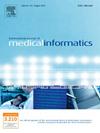机器学习诊断胃癌微卫星不稳定性的准确性:系统综述与荟萃分析。
IF 4.1
2区 医学
Q2 COMPUTER SCIENCE, INFORMATION SYSTEMS
International Journal of Medical Informatics
Pub Date : 2024-11-02
DOI:10.1016/j.ijmedinf.2024.105685
引用次数: 0
摘要
背景:在目前的临床实践中,早期识别微卫星不稳定性(MSI)仍然面临着巨大挑战。近年来,随着机器学习(ML)在胃癌(GC)诊断和管理中的应用日益广泛,许多研究人员探索了 ML 方法在检测 MSI 方面的有效性。然而,这些方法的预测价值仍缺乏全面的证据。因此,本研究旨在巩固 ML 在及时检测 GC 中 MSI 方面的准确性:方法:检索了截至 2024 年 3 月 20 日的 PubMed、Cochrane 图书馆、Web of Science 和 Embase。利用预测模型风险评估工具对所含研究的偏倚风险进行评估。然后根据建模变量对模型进行分组分析:共有 12 项研究符合预定的纳入标准,涵盖 11,912 名 GC 患者。这些研究建立的 ML 模型主要基于病理图像、临床特征和放射组学。结果表明,在验证集中,基于病理图像的模型的综合 c 指数为 0.86 [95 % CI (0.83-0.89)],灵敏度和特异度分别为 0.86 [95 % CI (0.76-0.92)] 和 0.83 [95 % CI (0.78-0.87)];基于放射组学特征的模型的综合 c 指数分别为 0.87[95%CI(0.81-0.92)]、0.77[95%CI(0.70-0.83)]和0.81[95%CI(0.74-0.87)];基于放射组学特征的模型+基于临床特征的模型分别达到0.87[95%CI(0.81-0.93)]、0.78[95%CI(0.70-0.84)]和0.79[95%CI(0.69-0.86)]:ML在检测GC中的MSI方面表现出最佳性能,可作为GC中MSI的前瞻性早期辅助检测工具。未来的研究应考虑采用微创或无创、易于收集和高效的预测指标来提高ML的预测准确性。本文章由计算机程序翻译,如有差异,请以英文原文为准。
Accuracy of machine learning in diagnosing microsatellite instability in gastric cancer: A systematic review and meta-analysis
Background
Significant challenges persist in the early identification of microsatellite instability (MSI) within current clinical practice. In recent years, with the growing utilization of machine learning (ML) in the diagnosis and management of gastric cancer (GC), numerous researchers have explored the effectiveness of ML methodologies in detecting MSI. Nevertheless, the predictive value of these approaches still lacks comprehensive evidence. Accordingly, this study was carried out to consolidate the accuracy of ML in the prompt detection of MSI in GC.
Methods
PubMed, the Cochrane Library, the Web of Science, and Embase were retrieved up to March 20, 2024. The risk of bias in the encompassed studies was evaluated utilizing a risk assessment tool for predictive models. Models were then subjected to subgroup analysis based on the modeling variables.
Results
A total of 12 studies, encompassing 11,912 patients with GC, satisfied the predefined inclusion criteria. ML models established in these studies were primarily based on pathological images, clinical features, and radiomics. The results suggested that in the validation sets, the pathological image-based models had a synthesized c-index of 0.86 [95 % CI (0.83–0.89)], with sensitivity and specificity being 0.86 [95 % CI (0.76–0.92)] and 0.83 [95 % CI (0.78–0.87)], respectively; radiomics feature-based models achieved respective values of 0.87 [95 % CI (0.81–0.92)], 0.77 [95 % CI (0.70–0.83)] and 0.81 [95 % CI (0.74–0.87)]; radiomics feature-based models + clinical feature-based models achieved respective values of 0.87 [95 % CI (0.81–0.93)], 0.78 [95 % CI (0.70–0.84)] and 0.79 [95 % CI (0.69–0.86)].
Conclusions
ML has demonstrated optimal performance in detecting MSI in GC and could serve as a prospective early adjunctive detection tool for MSI in GC. Future research should contemplate minimally invasive or non-invasive, readily collectible, and efficient predictors to augment the predictive accuracy of ML.
求助全文
通过发布文献求助,成功后即可免费获取论文全文。
去求助
来源期刊

International Journal of Medical Informatics
医学-计算机:信息系统
CiteScore
8.90
自引率
4.10%
发文量
217
审稿时长
42 days
期刊介绍:
International Journal of Medical Informatics provides an international medium for dissemination of original results and interpretative reviews concerning the field of medical informatics. The Journal emphasizes the evaluation of systems in healthcare settings.
The scope of journal covers:
Information systems, including national or international registration systems, hospital information systems, departmental and/or physician''s office systems, document handling systems, electronic medical record systems, standardization, systems integration etc.;
Computer-aided medical decision support systems using heuristic, algorithmic and/or statistical methods as exemplified in decision theory, protocol development, artificial intelligence, etc.
Educational computer based programs pertaining to medical informatics or medicine in general;
Organizational, economic, social, clinical impact, ethical and cost-benefit aspects of IT applications in health care.
 求助内容:
求助内容: 应助结果提醒方式:
应助结果提醒方式:


